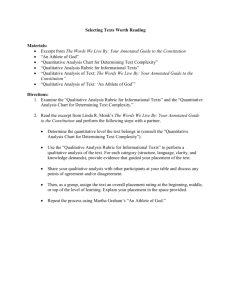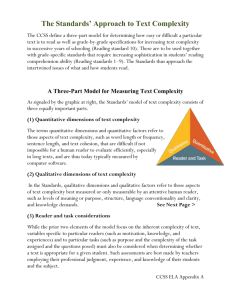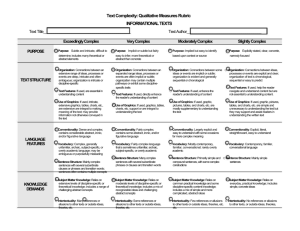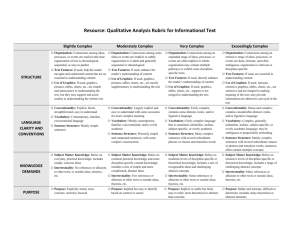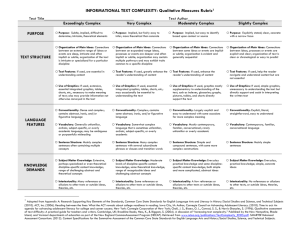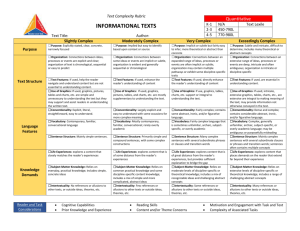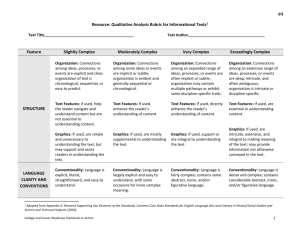Selecting Texts - Wyoming Community Colleges
advertisement
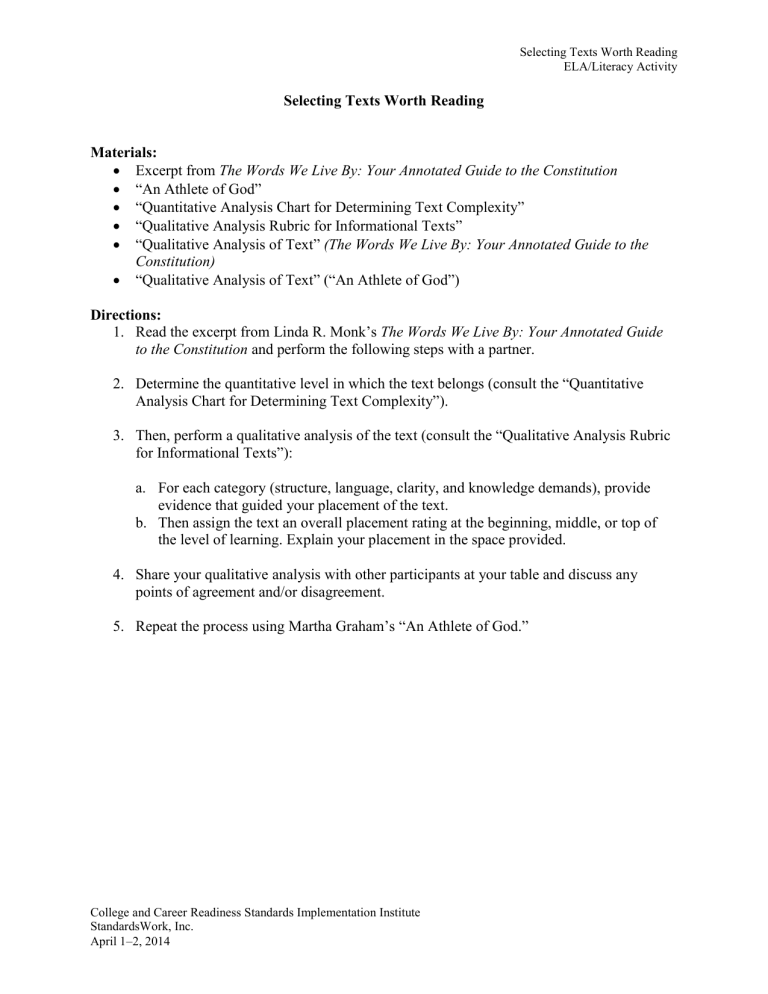
Selecting Texts Worth Reading ELA/Literacy Activity Selecting Texts Worth Reading Materials: Excerpt from The Words We Live By: Your Annotated Guide to the Constitution “An Athlete of God” “Quantitative Analysis Chart for Determining Text Complexity” “Qualitative Analysis Rubric for Informational Texts” “Qualitative Analysis of Text” (The Words We Live By: Your Annotated Guide to the Constitution) “Qualitative Analysis of Text” (“An Athlete of God”) Directions: 1. Read the excerpt from Linda R. Monk’s The Words We Live By: Your Annotated Guide to the Constitution and perform the following steps with a partner. 2. Determine the quantitative level in which the text belongs (consult the “Quantitative Analysis Chart for Determining Text Complexity”). 3. Then, perform a qualitative analysis of the text (consult the “Qualitative Analysis Rubric for Informational Texts”): a. For each category (structure, language, clarity, and knowledge demands), provide evidence that guided your placement of the text. b. Then assign the text an overall placement rating at the beginning, middle, or top of the level of learning. Explain your placement in the space provided. 4. Share your qualitative analysis with other participants at your table and discuss any points of agreement and/or disagreement. 5. Repeat the process using Martha Graham’s “An Athlete of God.” College and Career Readiness Standards Implementation Institute StandardsWork, Inc. April 1–2, 2014 Selecting Texts Worth Reading ELA/Literacy Activity Quantitative Analysis Chart for Determining Text Complexity ATOS Degrees of Reading Power FleschKincaid The Lexile Framework Reading Maturity SourceRater B (2nd – 3rd) 2.75 – 5.14 42 – 54 1.98 – 5.34 420 – 820 3.53 – 6.13 0.05 – 2.48 C (4th – 5th) 4.97 – 7.03 52 – 60 4.51 – 7.73 740 – 1010 5.42 – 7.92 0.84 – 5.75 D (6th – 8th) 7.00 – 9.98 57 – 67 6.51 – 10.34 925 – 1185 7.04 – 9.57 4.11 – 10.66 E (9th – 10th) 9.67 – 12.01 62 – 72 8.32 – 12.12 1050 – 1335 8.41 – 10.81 9.02 – 13.93 E (11th – CCR) 11.20 – 14.10 67 – 74 10.34 – 14.2 1185 – 1385 9.57 – 12.00 12.30 – 14.50 CCR Levels of Learning College and Career Readiness Standards Implementation Institute StandardsWork, Inc. April 1–2, 2014 2 Selecting Texts Worth Reading ELA/Literacy Activity Qualitative Analysis Rubric for Informational Texts Text Title___________________________________________ Exceedingly Complex STRUCTURE Moderately Complex Slightly Complex o Organization: Connections among an o Organization: Connections among some o Organization: Connections among ideas, extensive range of ideas, processes, or events are deep, intricate, and often ambiguous; organization is intricate or discipline-specific o Text Features: If used, are essential in understanding content o Use of Graphics: If used, intricate, extensive graphics, tables, charts, etc., are extensive and are integral to making meaning of the text; may provide information not otherwise conveyed in the text expanded range of ideas, processes, or events are often implicit or subtle; organization may contain multiple pathways or exhibit some disciplinespecific traits o Text Features: If used, directly enhance the reader’s understanding of content o Use of Graphics: If used, graphics, tables, charts, etc., support or are integral to understanding the text ideas or events are implicit or subtle; organization is evident and generally sequential or chronological o Text Features: If used, enhance the reader’s understanding of content o Use of Graphics: If used, graphics, pictures, tables, charts, etc., are mostly supplementary to understanding the text processes, or events are explicit and clear; organization of text is chronological, sequential, or easy to predict o Text Features: If used, help the reader navigate and understand content but are not essential to understanding content o Use of Graphics: If used, graphics, pictures, tables, charts, etc., are simple and unnecessary to understanding the text, but they may support and assist readers in understanding the written text o Conventionality: Dense and complex; o Conventionality: Fairly complex; o Conventionality: Largely explicit and o Conventionality: Explicit, literal, o contains considerable abstract, ironic, and/or figurative language Vocabulary: Complex, generally unfamiliar, archaic, subject-specific, or overly academic language; may be ambiguous or purposefully misleading Sentence Structure: Mainly complex sentences with several subordinate clauses or phrases and transition words; sentences often contain multiple concepts o Subject Matter Knowledge: Relies on PURPOSE Very Complex o Organization: Connections among an LANGUAGE CLARITY AND CONVENTIONS o KNOWLEDGE DEMANDS Text Author_____________________________________ o extensive levels of discipline-specific or theoretical knowledge; includes a range of challenging abstract concepts Intertextuality: Many references or allusions to other texts or outside ideas, theories, etc. o Purpose: Subtle and intricate, difficult to determine; includes many theoretical or abstract elements o o contains some abstract, ironic, and/or figurative language Vocabulary: Fairly complex language that is sometimes unfamiliar, archaic, subject-specific, or overly academic Sentence Structure: Many complex sentences with several subordinate phrases or clauses and transition words o Subject Matter Knowledge: Relies on o moderate levels of discipline-specific or theoretical knowledge; includes a mix of recognizable ideas and challenging abstract concepts Intertextuality: Some references or allusions to other texts or outside ideas, theories, etc. o Purpose: Implicit or subtle but fairly easy to infer; more theoretical or abstract than concrete College and Career Readiness Standards Implementation Institute StandardsWork, Inc. April 1–2, 2014 o o easy to understand with some occasions for more complex meaning Vocabulary: Mostly contemporary, familiar, conversational; rarely overly academic Sentence Structure: Primarily simple and compound sentences, with some complex constructions o Subject Matter Knowledge: Relies on o o common practical knowledge and some discipline-specific content knowledge; includes a mix of simple and more complicated, abstract ideas Intertextuality: Few references or allusions to other texts or outside ideas, theories, etc. Purpose: Implied but easy to identify based on context or source straightforward, easy to understand o Vocabulary: Contemporary, familiar, conversational language o Sentence Structure: Mainly simple sentences o Subject Matter Knowledge: Relies on o everyday, practical knowledge; includes simple, concrete ideas Intertextuality: No references or allusions to other texts, or outside ideas, theories, etc. o Purpose: Explicitly stated, clear, concrete, narrowly focused 3 Selecting Texts Worth Reading ELA/Literacy Activity Qualitative Analysis of Text Name of Text: Linda R. Monk, The Words We Live By: Your Annotated Guide to the Constitution Lexile: 1250 Type of Text (Literary/Informational): Informational Where to place within the level? Category Notes and comments on text, support for placement in this band Beginning of Level Middle of Level Top of Level NOT Suited to Level Structure Language Clarity and Conventions Knowledge Demands Purpose Overall Placement College and Career Readiness Standards Implementation Institute StandardsWork, Inc. April 1–2, 2014 4 Selecting Texts Worth Reading ELA/Literacy Activity Qualitative Analysis of Text Name of Text: Martha Graham, “An Athlete of God” Lexile: 970 Type of Text (Literary/Informational): Informational Where to place within the level? Category Notes and comments on text, support for placement in this band Beginning of Level Middle of Level Top of Level NOT Suited to Level Structure Language Clarity and Conventions Knowledge Demands Purpose Overall Placement College and Career Readiness Standards Implementation Institute StandardsWork, Inc. April 1–2, 2014 5

